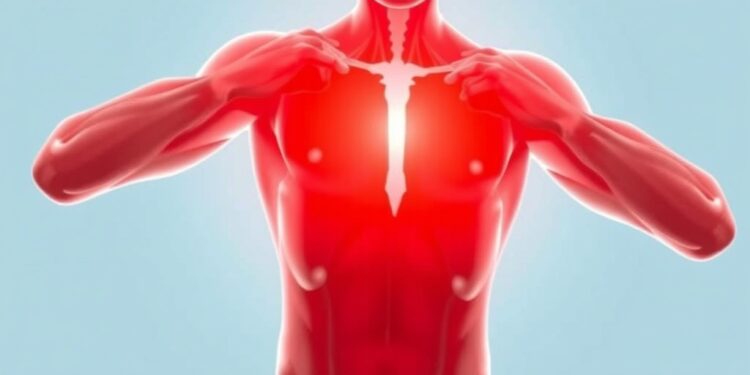
A groundbreaking study by researchers at the USC Dornsife College of Letters, Arts and Sciences has illuminated the complex mechanisms behind the formation of tiny protein clusters in human cells. This research holds significant potential for advancing treatments for Emery-Dreifuss muscular dystrophy (EDMD), a rare genetic disorder marked primarily by severe muscle weakness and various heart complications. With the interplay of advanced imaging techniques and principles of theoretical physics, the researchers have gained insights into the formation of nanoclusters of emerin, a crucial protein involved in cellular mechanotransduction—the reaction of cells to mechanical forces.
Emerin clusters, which are roughly 100,000 times narrower than a single human hair, are essential for cellular functionality. They allow cells to perceive and respond effectively to external stresses, such as stretching and pressure. Disruption in this mechanotransduction process is linked to several disorders, including muscular dystrophy, which underscores the relevance of this new research. Understanding how these nanoclusters misassemble can provide critical clues for developing therapeutic interventions aimed at restoring their functionality.
The study, published in the journal Physical Review Research, unveils the fundamental molecular rules that guide the arrangement of emerin into nanoclusters. By delving into the mechanics that lead to defective assembly in individuals suffering from EDMD, the researchers strive to address the underlying causes of the disease. The goal is to establish strategies to rectify the dysfunctional assembly processes and alleviate symptoms associated with this debilitating disorder.
At the forefront of this research are Christoph Haselwandter and Fabien Pinaud, who adopted a unique approach by integrating concepts rooted in the work of the iconic Alan Turing. Turing, renowned for his contributions during World War II and his groundbreaking ideas in computing, also laid foundational concepts for understanding pattern formation in nature. The researchers have applied Turing’s principles to unravel how tiny protein clusters, such as emerin, assemble at the nanoscale, thus unveiling the mathematical rules that govern biological processes.
The implications of this research extend beyond muscular dystrophy. A deeper comprehension of protein mechanisms, such as those exhibited by emerin, could catalyze breakthroughs related to various diseases that bear a connection to cellular mechanics. With many disorders thought to arise from cellular failures, this research paves the way for a broader understanding of mechanotransductive processes across diverse biological systems.
Carlos Alas, the first author of the study and a recent addition to the physics PhD community at USC Dornsife, expressed optimism regarding the prospects of this research. With a physics-centered approach, the research team can creatively explore avenues to correct the identified protein misassembly and potentially improve the quality of life for individuals suffering from EDMD. The collaborative nature of this research represents an exciting intersection of physics, biology, and medicine, which could yield transformative insights.
The innovative combination of imaging analysis and theoretical physics makes this research particularly distinctive. By utilizing advanced imaging techniques, the team was able to visualize the emerin nanoclusters in living cells. This unprecedented ability to observe molecular processes in real-time offers an invaluable resource for understanding how mechanical forces influence cellular behavior at a molecular level, allowing researchers to map out the pathways that lead to both normal and pathological processes.
Turing’s legacy in the realm of mathematics and biology is evident as the researchers adopt his concepts to navigate the complexities of protein assembly. By formulating a theoretical model that elucidates how these tiny clusters form, the researchers have provided a framework that demystifies the processes at play. This opens up new avenues for applied research aimed at addressing various cellular dysfunctions.
As the landscape of muscular dystrophy research expands, the findings from this study could serve as a beacon for future explorations into not only muscular dystrophies but also a myriad of other vascular and neurological conditions. With a growing understanding of how proteins misfunction in various diseases, the potential for therapeutic interventions can start to materialize, providing hope for those affected by such devastating health issues.
The research team anticipates that their findings will encourage further exploration into the mechanisms of cellular mechanics, which could be foundational for future studies intended to address complex diseases. As they continue to unravel the intricacies of cellular behaviors, the implications of their work could grow, offering transformative advantages for both scientific and medical communities.
In summary, this research not only sheds light on the peculiarities of emerin protein clusters but also exemplifies a productive marriage of physics and biological science. The techniques and insights developed in this study have the potential to lead to novel strategies for tackling a range of diseases that arise from mechanical malfunctions within cells, potentially ushering in a new era of innovative therapeutic options for patients.
Subject of Research: Nanoclusters of emerin protein and their role in mechanotransduction related to Emery-Dreifuss muscular dystrophy.
Article Title: Diffusion-driven self-assembly of emerin nanodomains at the nuclear envelope.
News Publication Date: 23-Jan-2025.
Web References: Physical Review Research.
References: DOI: 10.1103/PhysRevResearch.7.L012019
Image Credits: USC Dornsife College of Letters, Arts and Sciences.
Keywords
Nanoclusters, mechanotransduction, Emery-Dreifuss muscular dystrophy, protein assembly, cellular mechanics, theoretical physics.
Tags: advanced imaging techniques in biologycellular mechanotransduction mechanismsemerin protein and muscle weaknessEmery-Dreifuss muscular dystrophy researchmolecular rules of protein assemblymuscle disorders and heart complicationsmuscular dystrophy treatment advancementsnanoclusters in human cellsprotein cluster formation in cellstheoretical physics in medical researchtherapeutic interventions for muscular dystrophyUSC Dornsife College research breakthroughs





